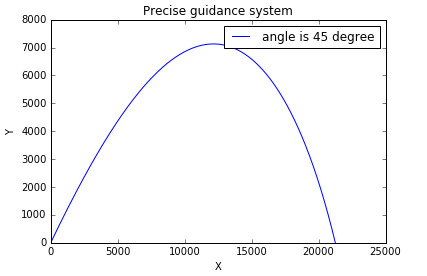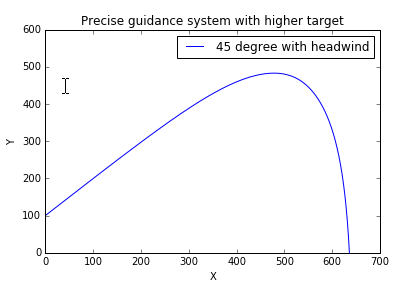@zy-0815
2016-11-27T17:34:14.000000Z
字数 6574
阅读 1422
计算物理第六次作业
摘要
此次作业为2.10的强化版,引入了迎面风阻,即完成L1。
背景介绍
上次作业中我们通过Euler法完成了对炮弹轨迹的探讨,同时此次探讨偏向理想化探讨,然则在实际问题中我们还要考虑风阻等各种问题,因此此次作业变加强了对实际性问题的研究
正文
1、对于标准情况,即考虑风阻的情况并引入绝热模型分析海拔对风阻影响。
绝热模型公式为:
其中,我们很快写出此时的方程如下:
由此,我们可以写出程序果如下,注:以下为的情况
import pylab as plimport mathclass cannon :def __init__(self,i=0,air_resistance=0.00004,power=10,mass = 1,time_step=0.1,\initial_velocity=700,initial_x=0,initial_y=0,\initial_velocity_x=700*math.cos(math.pi/4),\initial_velocity_y=700*math.sin(math.pi/4)):self.x = [initial_x]self.y = [initial_y]self.vx = [initial_velocity_x]self.vy = [initial_velocity_y]self.v = [initial_velocity]self.t = [0]self.m = massself.p = powerself.B_2 = air_resistanceself.dt = time_stepdef run(self):while(1):s1=self.x[-1] + self.vx[-1]*self.dts2=self.y[-1] + self.vy[-1]*self.dtv1=self.vx[-1] - self.dt *pow((1-(0.0065*self.y[-1])/300),2.5)*\(self.B_2 / self.m) *self.v[-1] * self.vx[-1]v2=self.vy[-1] - 9.8*self.dt - self.dt *\pow((1-(0.0065*self.y[-1])/300),2.5)*(self.B_2 / self.m) *\self.v[-1] * self.vx[-1]self.x.append(s1)self.y.append(s2)self.v.append(math.sqrt(self.vx[-1]*self.vx[-1] + self.vy[-1]*self.vy[-1]))self.vx.append(v1)self.vy.append(v2)if(s2<0):breakdef show_results(self):pl.plot(self.x,self.y,'b',label='angle is 45 degree')pl.title('Precise guidance system')pl.xlabel('X')pl.ylabel('Y')pl.legend()pl.ylim(0,)pl.show()a = cannon()a.run()a.show_results()
程序运行结果如图:

2、考虑迎面风阻,由书上(2.26)可知公式为
其中,以及
由此可知程序应为:
import pylab as plimport mathclass cannon :def __init__(self,i=0,air_resistance=0.00004,power=10,mass = 1,time_step=0.1,\initial_velocity=700,initial_x=0,initial_y=0,\initial_velocity_x=700*math.cos(math.pi/4),\initial_velocity_y=700*math.sin(math.pi/4)):self.x = [initial_x]self.y = [initial_y]self.vx = [initial_velocity_x]self.vy = [initial_velocity_y]self.v = [initial_velocity]self.t = [0]self.m = massself.p = powerself.B_2 = air_resistanceself.dt = time_stepdef run(self):while(1):s1=self.x[-1] + self.vx[-1]*self.dts2=self.y[-1] + self.vy[-1]*self.dtv1=self.vx[-1] - self.dt *pow((1-(0.0065*self.y[-1])/300),2.5)*\(0.0039+0.0058/(1+math.exp((self.v[-1]-35)/5)))*\self.v[-1] * self.vx[-1]v2=self.vy[-1] - 9.8*self.dt - self.dt *\pow((1-(0.0065*self.y[-1])/300),2.5)*(0.0039+\0.0058/(1+math.exp((self.v[-1]-35)/5))) *\self.v[-1] * self.vx[-1]self.x.append(s1)self.y.append(s2)self.v.append(math.sqrt(self.vx[-1]*self.vx[-1] + self.vy[-1]*self.vy[-1]))self.vx.append(v1)self.vy.append(v2)if(s2<0):breakdef show_results(self):pl.plot(self.x,self.y,'b',label='angle is 45 degree')pl.title('Precise guidance system')pl.xlabel('X')pl.ylabel('Y')pl.legend()pl.ylim(0,)pl.show()a = cannon()a.run()a.show_results()
运行结果为:

由此对比看出,当考虑迎面风阻的时候,炮弹所打的距离明显减小;
3、考虑目标位置的变化时(初始海拔为100m),如比原位置更高时候,程序可修改为:
import pylab as plimport mathclass cannon :def __init__(self,i=0,air_resistance=0.00004,power=10,mass = 1,time_step=0.01,\total_time=100, initial_velocity=700,initial_x=0,initial_y=100,\initial_angle=45,angle_c=math.pi/180):self.x = [initial_x]self.y = [initial_y]self.v = [initial_velocity]self.vx= [initial_velocity*math.cos(initial_angle*angle_c)]self.vy= [initial_velocity*math.sin(initial_angle*angle_c)]self.t = [0]self.m = massself.p = powerself.B_2 = air_resistanceself.dt = time_stepself.time = total_timedef run(self):while(1):s1=self.x[-1] + self.vx[-1]*self.dts2=self.y[-1] + self.vy[-1]*self.dtv1=self.vx[-1] - self.dt *pow((1-(0.0065*self.y[-1])/300),2.5)*(0.0039+\0.0058/(1+math.exp((self.v[-1]-35)/5))) *\self.v[-1] * self.vx[-1]v2=self.vy[-1] - 9.8*self.dt - self.dt *\pow((1-(0.0065*self.y[-1])/300),2.5)*(0.0039+\0.0058/(1+math.exp((self.v[-1]-35)/5))) *\self.v[-1] * self.vx[-1]self.x.append(s1)self.y.append(s2)self.v.append(math.sqrt(self.vx[-1]*self.vx[-1] + self.vy[-1]*self.vy[-1]))self.vx.append(v1)self.vy.append(v2)if(v2<0 and s2<200):s1=self.x[-1] + self.vx[-1]*0.001s2=self.y[-1] + self.vy[-1]*0.001v1=self.vx[-1] - 0.001 *pow((1-(0.0065*self.y[-1])/300),2.5)*(0.0039+\0.0058/(1+math.exp((self.v[-1]-35)/5))) *\self.v[-1] * self.vx[-1]v2=self.vy[-1] - 9.8*0.001 - 0.001 *\pow((1-(0.0065*self.y[-1])/300),2.5)*(0.0039+\0.0058/(1+math.exp((self.v[-1]-35)/5))) *\self.v[-1] * self.vx[-1]self.x.append(s1)self.y.append(s2)self.v.append(math.sqrt(self.vx[-1]*self.vx[-1] + self.vy[-1]*self.vy[-1]))self.vx.append(v1)self.vy.append(v2)if(s2<200):breakbreakdef show_results(self):pl.plot(self.x,self.y,'b',label='45 degree with headwind')pl.title('Precise guidance system with higher target')pl.ylim(0,600)pl.xlabel('X')pl.ylabel('Y')pl.legend()pl.show()a = cannon()a.run()a.show_results()
运行结果为:

对于较低海拔,程序为:
import pylab as plimport mathclass cannon :def __init__(self,i=0,air_resistance=0.00004,power=10,mass = 1,time_step=0.01,\total_time=100, initial_velocity=700,initial_x=0,initial_y=100,\initial_angle=45,angle_c=math.pi/180):self.x = [initial_x]self.y = [initial_y]self.v = [initial_velocity]self.vx= [initial_velocity*math.cos(initial_angle*angle_c)]self.vy= [initial_velocity*math.sin(initial_angle*angle_c)]self.t = [0]self.m = massself.p = powerself.B_2 = air_resistanceself.dt = time_stepself.time = total_timedef run(self):while(1):s1=self.x[-1] + self.vx[-1]*self.dts2=self.y[-1] + self.vy[-1]*self.dtv1=self.vx[-1] - self.dt *pow((1-(0.0065*self.y[-1])/300),2.5)*(0.0039+\0.0058/(1+math.exp((self.v[-1]-35)/5))) *\self.v[-1] * self.vx[-1]v2=self.vy[-1] - 9.8*self.dt - self.dt *\pow((1-(0.0065*self.y[-1])/300),2.5)*(0.0039+\0.0058/(1+math.exp((self.v[-1]-35)/5))) *\self.v[-1] * self.vx[-1]self.x.append(s1)self.y.append(s2)self.v.append(math.sqrt(self.vx[-1]*self.vx[-1] + self.vy[-1]*self.vy[-1]))self.vx.append(v1)self.vy.append(v2)if(s2<0):s1=self.x[-1] + self.vx[-1]*0.001s2=self.y[-1] + self.vy[-1]*0.001v1=self.vx[-1] - 0.001 *pow((1-(0.0065*self.y[-1])/300),2.5)*(0.0039+\0.0058/(1+math.exp((self.v[-1]-35)/5))) *\self.v[-1] * self.vx[-1]v2=self.vy[-1] - 9.8*0.001 - 0.001 *\pow((1-(0.0065*self.y[-1])/300),2.5)*(0.0039+\0.0058/(1+math.exp((self.v[-1]-35)/5))) *\self.v[-1] * self.vx[-1]self.x.append(s1)self.y.append(s2)self.v.append(math.sqrt(self.vx[-1]*self.vx[-1] + self.vy[-1]*self.vy[-1]))self.vx.append(v1)self.vy.append(v2)if(s2<200):breakbreakdef show_results(self):pl.plot(self.x,self.y,'b',label='45 degree with headwind')pl.title('Precise guidance system with higher target')pl.ylim(0,600)pl.xlabel('X')pl.ylabel('Y')pl.legend()pl.show()a = cannon()a.run()a.show_results()
运行结果为:

结论
(1)引入迎面风阻后,炮弹的轨迹明显变小,而这其实与初始速度有关,运行不同的初始速度,轨迹也会大不相同;
(2)对于不同高度的目标,炮弹射速和角度也有显然变化。
致谢
感谢宗玥同学的耐心帮助。
